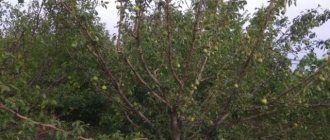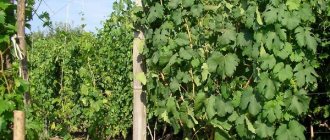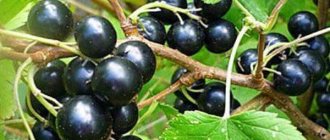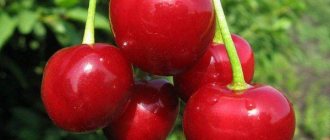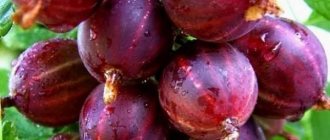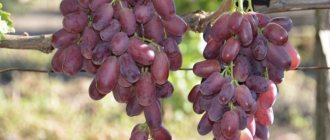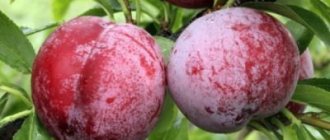The quality of the future harvest directly depends on the correctly selected grape variety for planting. Ruby Jubilee is a variety that is easy to care for and bears fruit abundantly. Large sweet berries, powerful clusters and a strong vine - these are the characteristics gardeners give in their reviews of the variety.
What type does it belong to?
Ruby Jubilee is a hybrid table subspecies. Table hybrids also include Zarya Nesvetaya, Russian Korinka and Ataman Pavlyuk.
Harvest ripening period is early-medium. The berries ripen by the end of August, but it is better to wait until mid-September and then pick them.
The point here is not only in sugar accumulation - it turns out that Ruby Jubilee turns into a “ripe” color much earlier than the berries acquire all those qualities that are inherent in ripe grapes.
It is used in bouquets of red table and dessert wines, but is also good fresh, thanks to its sweetness and rich, revealing taste with noticeable muscat, rose and strawberry notes.
Velika, Krasa Balki and Romeo also boast excellent taste.
It is in great demand among buyers not only because of its beauty and sweetness, but also because of the fruit’s extraordinary resistance to storage and transportation.
Gardeners often confuse Ruby Jubilee with Anyuta early, believing that they are the same variety. But this is not so, even in appearance - the clusters of Ruby Jubilee are richly red, and Anyuta early is golden-pink. Yes, and it ripens earlier.
Pharaoh, Sangiovese, Violet early and Rochefort also have an early ripening period.
Feeding
Gardeners note that they first need to apply fertilizer in early spring. For this purpose, bird droppings with Nitrophoska, ash and urea are widely used. 3 weeks before flowering, grapes are fed with zinc and boron at the rate of 5 g per 10 liters of water. At the end of flowering, the same fertilizer is applied. The leaves should be sprayed with a solution of manganese sulfate. For 10 liters of water there should be from 20 to 30 g of concentrated substance. In addition, once every 2 weeks it is necessary to spray the plant with iron sulfate.
In the summer, fertilizing is applied to the bushes, for the preparation of which 30 g of phosphorus and 50 g of potassium and nitrogen are used. The same amount of potassium, as well as 25 g of phosphorus, is poured into the soil at the beginning of berry ripening, after which feeding is stopped for a while. Only at the end of the harvest you need to apply 50 g of potassium fertilizer under the bush.
Grapes Ruby Jubilee: variety description
The bushes are medium-sized. The bunch is medium-sized, cylindrical, moderately dense, up to 1 kg. Rarely peas. The berry is oval, very large, weighing on average 17 g, deep red in color with a ruby tint and on a strong stalk. This is the only way, no golden ones with a pinkish tint - this is Anyuta early, with which Ruby is quite often confused.
Such varieties as Lydia, Pinot Noir and Golubok are also distinguished by their medium height.
The skin of the berry is of medium thickness, almost unnoticeable when eating, the pulp is juicy, crunchy, with a nutmeg flavor and pink notes. The leaf is dark green, medium size, rounded, medium dissected. The flower is hermaphrodite. The ripened shoot is brown with red nodes.
Features of agricultural technology
Grapes Nadezhda Aksayskaya
It is difficult to imagine a better grape variety for the Voronezh region than Mukuzani. However, if desired, it can be grown in more northern regions of Russia. To do this, you will have to compensate for the not very suitable climate with rich, fertile soil. Caring for grapes of this variety is not much different from how to care for other varieties that do not require shelter.
Disembarkation
For grapes, soil with neutral acidity will be optimal. It is necessary to first add complex mineral fertilizers. Two weeks before the seedlings find their permanent place in the ground, it must be dug up, weeds must be removed and the larvae of all insects destroyed. To plant cuttings, you need to choose a warm spring day so that the first period of adaptation of the plant takes place in mid-spring.
Planting grapes
Two or three days before planting in the ground, the seedlings stop watering so that a lump of earth forms around the cuttings. In a trench that has been prepared in advance, planting holes are made with a diameter of 30 cm and a depth of 25-30 cm. Fragments of red brick, or just lumps of clay, are placed at the bottom of the hole. Fertile soil mixed with fine sand is poured on top of the mound. The plant, along with a lump of earth, is placed on a mound. Before filling the planting hole, place a handful of ash in the root area. The hole is filled up to the second eye of the cutting. Planting is completed with abundant watering.
Note! Some experienced winegrowers add a handful of barley to the hole, under the roots of the plant. It is believed that the cereal will help the roots to gain a foothold.
Trimming
Mukuzani grapes need regular thinning of bushes and pruning of excess shoots. If this is not done in time, the berries most likely will not ripen completely, and the development of the vine will be uneven. Spring pruning of uncovered grape varieties is carried out in the first or second ten days of March, depending on the duration of winter. This operation must be performed before the buds swell and intense sap flow begins. During the winter, some shoots freeze and need to be removed.
Grape pruning
In the fall, the vine is pruned so that it is better prepared for winter.
Breaking off
First of all, underdeveloped shoots growing from below are broken off. Double and triple shoots are also subject to removal. The most developed shoots remain and thanks to them, subsequent rejuvenation of the bush occurs. This operation, along with pinching, allows you to regulate the future harvest.
Topping
To prevent the plant from stretching in length, the tops of green shoots are removed. As a result of this operation, the main flow of nutrients will be directed to the inflorescences. This needs to be done two or three days before flowering.
Pinching grapes
Weeding
In order for the vineyard to develop normally, it needs to be weeded regularly. Near the vineyard there should be no weeds or extra plants that feed on grape juice. The top part of the soil can be periodically replaced with new, more nutritious soil.
Pest Control
Vineyard protection from pests should be carried out systematically, regardless of whether insects are present on the plants or not. Moreover, this should be done before the flowering period.
Currently, there are few diseases and pests in the northern regions of Russia. Mainly northern vineyards suffer from powdery mildew (oidium). Those who want to get an environmentally friendly harvest can be advised to use biological products instead of “chemistry”. Russian winegrowers treat oidium with a ten percent infusion of mullein. In the USA, a new method has recently been developed to combat this disease, which involves the use of a whey solution.
Additional Information. If you plant a rose at the ends of the trellis, it will be the first to signal the onset of the disease and the need to take certain measures.
Photo
Photo of Ruby Jubilee grapes:
Planting seedlings
Planting young seedlings in a permanent place is an important stage, during which the foundation is laid not only for the harvest, but also for the plant’s immunity.
Preparing the landing site
For planting, choose open sunny areas. Since grapes belong to the southern plants, where there is a lot of sunlight and heat, the bushes grow very poorly in the shade and practically do not produce a harvest.
In addition, it is important that the area is protected from the wind. The best option for planting would be the walls of the house on the south side. Before planting, you should step back 1 m from the wall. Grapes prefer to grow on loamy or sandy loam soils.
Setting the stage
Stages of preparing a site for planting grape seedlings:
- Dig a hole to a depth of 80 cm.
- Fill the bottom with fine drainage.
- Then mix the top layer of soil with manure and mineral fertilizers for growth and fill the hole with the resulting soil mixture.
- Leave the place for 1-2 weeks.
If necessary, deoxidize the soil with dolomite flour. It is not recommended to plant grape bushes on acidic soils. After 7-14 days, they begin to plant the seedling.
When can I plant
It is recommended to plant the Ruby Jubilee hybrid in early October and before the onset of the first autumn frosts. Over the winter, the seedlings will have time to take root, and in the spring they will begin to grow actively. You can also plant grape bushes in the spring, after the snow has melted and the weather has warmed up.
Description of actions: what's behind what
Stages of planting a seedling in open ground:
- Dig a hole with parameters 80 x 80 x 80.
- Drive a metal pipe into the bottom of the hole and another one nearby.
- Drainage is poured to the bottom, and then 150 g of potash fertilizers.
- Place the seedling in the hole and cover it with soil.
- Lightly compact near the trunk.
At the end of planting, water generously with warm water. Grape seedlings are not recommended to be planted next to other plants. It is undesirable to bury the seedling, this will negatively affect the growth of the plant. If you plant only female varieties, then over time the crop will become smaller. Any pollinating variety must be planted nearby.
Liven chickens: description of the calico breed
History of selection
The ruby jubilee was bred by amateur breeder V.N. Krainov as a gift to his wife for the ruby wedding - the fortieth anniversary of their marriage.
This breeder also owns Blagovest, Victor and Angelika.
Farmers immediately appreciated this variety. Currently, Ruby Jubilee is grown in the Kherson region, Zaporozhye, Crimea, Rostov region, and Krasnodar region. It is not found in the central regions due to the fact that it does not tolerate severe cold, which is characteristic of most of Russia.
Useful video
More details about the Ruby Jubilee grapes can be found in the video below:
If you find an error, please select a piece of text and press Ctrl+Enter.
Ruby Jubilee is a hybrid form of table grape, bred by one of the founders of domestic folk selection, Viktor Krainov from Novocherkassk. Since 1953, Viktor Nikolaevich has been growing sunberries on his plot on the banks of the Tuzla River, and after decades of practical viticulture, he decided to also engage in the selection of new hybrids. The first impetus for research activities and enormous theoretical support along this path were provided to Krainov by the famous scientist from the All-Russian Research Institute of Viticulture and Winemaking, Ivan Kostrikin. The result of a successful symbiosis of carriers of a gigantic store of theoretical knowledge and practical experience was the appearance of many magnificent varieties, the best of which were even included in the State Register of Breeding Achievements of the Russian Federation. But those creations of Krainov, which were not awarded such an honor, have, for the most part, become very popular among grape lovers and currently grow on vast areas of farm and summer cottage plots.
One of these hybrids, widespread in amateur plantings, is Ruby Jubilee - a large-fruited grape with berries that are stunning in color, taste and aroma. It received its name in connection with the 40th anniversary of Viktor Nikolaevich’s married life with his other half. Such a round date is popularly called a ruby wedding. So the author presented his wonderful new product as a gift to his wife.
The parent pair of this grape variety was the breeder's favorites - the varieties Talisman and Kishmish radiant. The first is distinguished by the gigantic size of bunches and berries, relative resistance to disease and frost, as well as a functionally female type of flowering, making it very convenient for enthusiastic researchers. The second representative of the pair, Kishmish radiata, was responsible for the magnificent aesthetic and taste qualities of the future offspring. This combination of crossing turned out to be perhaps Krainov’s most productive - at different periods of time, he identified several promising hybrids through it, including his famous “troika” - Preobrazhenie, Jubilee of Novocherkassk and Victor. And here it is worth noting that Ruby Jubilee is absolutely not behind its illustrious brothers, and in some respects, in particular in its wonderful aroma, it even surpasses them.
Characteristics
The variety is strong and unbending, as it should be a symbol of true love. He is not afraid of powdery mildew - oidium and mildew, or various types of rot, or other bacterial diseases of grapes.
True, it is not very resistant to wasps. The yield of the variety is high, it needs to be rationed with eyes and shoots. Trim to six to eight eyes, leaving the norm at 35 per bush.
It requires mandatory shelter for the winter, since the maximum permissible “minus” for Ruby is 22 degrees Celsius. Afraid of rain.
In unfavorable years, the flowers fall off greatly. The ripening of the vine is almost the entire length of the growth. The percentage of sugar content is up to 20 Brix.
Vodograi, Tien Shan and Rozmus also prefer to spend the winter in shelter.
How to care
In the first year of growing the crop, the seedling is not often watered (once a month), the soil is loosened and treated with fungicidal preparations against diseases and pests. The first watering is carried out immediately after planting the seedling in a permanent place. After watering, the soil is loosened; if weeds appear, they are pulled out. When the first leaves begin to actively grow, the trunk is freed from the earthen layer. In June, a hole is made around the plant so that the surface roots get used to the surrounding temperature. If the roots are not hardened, the plant will form slowly and sluggishly. The hole is buried only in mid-August, when it gets noticeably colder outside.
You can form a vine from the first year of growing the crop. The strongest and most powerful shoot is left, and the rest is cut off. Subsequent pruning is carried out in the fall, after harvest and in the spring. First of all, old, dried branches or weak shoots are removed. For pruning you need pruning shears or a sharp knife; breaking off branches is undesirable, as you can damage the vine.
On a note!
The cut areas of the branches are treated with potassium permanganate or hydrogen peroxide.
Diseases and pests
This “symbol of love” definitely needs protection from wasps. Therefore, the clusters must be packed in special mesh bags. They will provide access to sun and fresh air, but will not allow striped invaders to get to the berries.
It is also good to use sticky baits, preferably odorless. All wasp families and “family estates” found on the site must be destroyed.
Please note that wasps simply love to build nests in hollow pipes that support bushes. Therefore, all these holes will have to be sealed.
The birds will also be stopped by a net - just not a fishing net, but a hard and fine-mesh one. The bird will not get confused in it and will simply fly away.
You will definitely need to spray the bush against grape budworms.
These weevils literally eat everything they see, and what they don’t eat, they bite it off, and no one will need your harvest: it will either dry out or rot.
Therefore, we spray the bushes with chemicals - these include Tsimbush, Tokution, Sevin, Tsidial, Sumicidin, Ekamet, Fozalon. Light traps against long-nosed moths are ineffective, and even then, males usually “peck” at them.
Do not forget also about preventive measures against rubella, chlorosis, anthracnose and bacteriosis. They will never hurt and will avoid many troubles.
Everything that is based on love lasts a long time. Ruby Jubilee will also live for a long time, including on your site.
Just don’t be lazy, take care of it, cover it for the winter months, spray it against pests, put up nets against wasps and birds - and then you and everyone who comes to your house will enjoy both the beauty of the grapes and the wonderful berries and homemade wine.
How to plant
It is better to locate the area for grapes on the south side or in the southwestern part. It is necessary to think about protection from the wind; there may be, for example, a fence on the north side. Grapes are not grown near trees; the shady zone is destructive for them. The groundwater level must be at least 1.5 m. Soil for the crop is laid in autumn or spring. Planting holes are dug in the ground 70-80 cm deep and with approximately the same diameter. First pour a bucket of any drainage into the hole, and then ½ kg of superphosphate and a bucket of humus.
Planting of seedlings begins in the spring, in early or mid-April. During the day, the seedling is soaked in a solution that stimulates the development and growth of the rhizome. The growth stimulator should consist of succinic acid, sodium humate, and root. Such a nutrient mixture will give strength to the roots, and they will quickly adapt to the new place. The roots of the seedling are immersed in a hole with fertile soil and dug in, leaving the root collar outside. For the first 2 weeks of cultivation, the seedlings are slightly shaded.
Reviews
Pavel from Krasnodar region says:
“Ruby Jubilee caught my attention with its beautiful berries. I have been growing it for 4 years in a row in my summer cottage. Fruiting occurs every year and is stable. The berries are always sweet and large, not prone to shrinking. I started using fertilizers last year. I fed the grapes before and after flowering with a potassium supplement (1 tbsp per 10 liters of water). Fruiting began 2 weeks earlier than usual.”
Anna from the Ivanovo region says:
“I was worried that the seedlings would not take root in the ground due to their low frost resistance. Indeed, some plants died, but most remained. I planted grapes in April, in the middle of the month, but spring was late and it was cold at night. The remaining plants have bloomed, I hope that I will harvest soon.”
Subscribe to our channel in Yandex.Zen! Click “Subscribe to channel” to read Ogorod-bez-hlopot.ru in the Yandex feed
